#kitchen medicine
Text
If you want to support Ukrainians, DO NOT donate to Red Cross. Can't speak about their work in other countries, but they're useless in Ukraine. The only trustworthy international organisation I can think of is World Central Kitchen.
Donate to World Central Kitchen

And it's even better to donate directly to Ukrainian organisations. Here are a few good legit places:
hospitallers.life - "Hospitallers", Ukrainian paramedics on the frontlines
savelife.in.ua - "Come Back Alive", assistance to the army
prytulafoundation.org - "Prytula Foundation", assistance to the army, humanitarian causes
starenki.com.ua - "Starenki", helping elderly people
everybodycan.com.ua - "Everybody Can", helping disabled children, elders and hospitals
uanimals.org - "UAnimals", saving animals

#Ukraine#wck#world central kitchen#donation#charity#red cross#russia#russia is a terrorist state#genocide#stand with ukraine#support ukraine#genocide of ukrainians#russian war crimes#war#support#help#link#words#typography#text#txt#donate#children#elderly care#animals#army#medicine#food#disability#fundraising
1K notes
·
View notes
Text
7 Simple Home Remedies for Insomnia
7 Simple Home Remedies for Insomnia
Before diving into the content of 7 Simple Home Remedies for Insomnia, I would like to recommend a book that I believe would be a precious resource The Home Doctor — Practical Medicine for Every Household. This book is a unique companion for the nonprofessional that you can use when help isn’t on the way or to manage common affections that do not bear seeing a croaker

Yes, drug can be expensive in the United States, compared to other advanced countries. The reasons for this include high costs of exploration and development, lack of price regulation, and the fact that the United States doesn’t have a universal healthcare system. This means that cases and insurance companies must pay for the cost of medicines and treatments, which can lead to advanced prices for drug. also, the cost of healthcare in the US is advanced in general, which also contributes to the high cost of drug.
• This book is a great resource for anyone interested in natural and holistic mending styles.
• It covers a wide range of common affections and ails, and provides detailed information on how to treat them using natural remedies and tone- care ways.
• The book is written by educated medical professionals and is backed by scientific exploration.
• The book’s approach is easy to understand and follow, which makes it accessible to people of all periods and backgrounds.
• It’s an excellent companion for those who want to take control of their own health and heartiness.
• The book is also a great resource for those who want to learn further about precautionary care and how to help ails before they do.
It’s a must- read for anyone looking to ameliorate their overall well- being and live a healthier, happier life.
What is Insomnia
Insomnia is a common sleep disorder that affects millions of people worldwide. It is characterized by difficulty falling asleep, staying asleep, or both. Insomnia can be caused by a variety of factors, including stress, anxiety, depression, chronic pain, medication side effects, and poor sleep hygiene. It can lead to a host of negative consequences, including fatigue, irritability, poor concentration, and an increased risk of accidents and illnesses. In this blog post, we will explore 7 simple home remedies that can help alleviate insomnia and improve sleep quality.
Bottom of Form
There are several home remedies for insomnia that you can try. Here are a few:
1. Establish a routine: Go to bed and wake up at the same time every day, even on weekends. This will help regulate your body’s internal clock.
2. Relax before bed: Try to relax your mind and body before bed. This can include activities such as reading, taking a warm bath, or practicing yoga.
3. Avoid stimulating activities: Avoid activities that can keep you awake, such as watching TV or using your phone or computer right before bed.
4. Avoid caffeine, nicotine, and alcohol: These substances can interfere with your ability to fall asleep.
5. Avoid big meals and heavy snacks: Eating too close to bedtime can cause indigestion and discomfort that can keep you awake.
6. Make your bedroom comfortable: Keep your bedroom dark, cool, and quiet. Use comfortable bedding and pillows.
7. Consider herbal remedies: Some herbs such as valerian root, passionflower, and melatonin supplements may help with insomnia.
Herbal teas (such as chamomile or valerian root)
Herbal teas, such as chamomile and valerian root, can be helpful in treating insomnia as they contain compounds that have a calming and sedative effect on the body.
Chamomile tea, for example, is known for its calming properties and is often used as a natural remedy for insomnia, anxiety and stress. It contains compounds called apigenin and luteolin which bind to specific receptors in the brain and promote relaxation.
Valerian root tea, on the other hand, has been used for centuries as a natural remedy for insomnia and anxiety. It contains compounds called valerenic acid and valepotriates which have a sedative effect on the body. These compounds interact with the GABA receptors in the brain which help to promote relaxation and reduce anxiety.
Essential oils (such as lavender or cedarwood)
Essential oils, such as lavender and cedarwood, can be helpful in treating insomnia as they contain compounds that have a calming and sedative effect on the body.
Lavender oil, for example, is known for its calming and relaxing properties and has been traditionally used to help with insomnia, anxiety, and stress. The aroma of lavender oil has been shown to have a calming effect on the nervous system, which can promote relaxation and help improve sleep.
Cedarwood oil is also known for its calming and sedative properties. It contains compounds called sesquiterpenes which have been shown to have a relaxing effect on the nervous system, helping to reduce anxiety and promote sleep.
It’s important to note that essential oils should be used with caution and in low concentrations. Some people may have an allergic reaction to certain oils, so it’s best to do a patch test before using them
Relaxation techniques (such as deep breathing or yoga)
Relaxation techniques, such as deep breathing and yoga, can be helpful in treating insomnia as they can promote relaxation and reduce stress and anxiety.
Deep breathing exercises, for example, can help to slow down the heart rate and lower blood pressure, promoting a state of relaxation. The practice of diaphragmatic breathing, where you focus on breathing deeply into your diaphragm, can help to release tension and promote relaxation.
Yoga is another relaxation technique that can be helpful for insomnia. Yoga combines physical postures, breathing exercises, and meditation to help reduce stress and anxiety. Certain yoga poses, such as legs-up-the-wall pose, can help to relax the body and calm the mind. Yoga also helps to reduce tension and improve sleep.
Relaxation techniques can be incorporated into a bedtime routine to help prepare the body and mind for sleep. It’s best to practice these techniques at least 30 minutes before bedtime and in a quiet, dark, and cool environment.
Dietary changes (such as avoiding caffeine or eating a high-protein snack before bed)
Dietary changes, such as avoiding caffeine or eating a high-protein snack before bed, can be helpful in treating insomnia as they can affect the hormones and neurotransmitters that regulate sleep.
Caffeine, for example, is a stimulant that can disrupt sleep by blocking the action of adenosine, a hormone that regulates sleep. Caffeine can also increase the release of certain neurotransmitters, such as dopamine and norepinephrine, that can make it harder to fall asleep. It’s recommended to avoid consuming caffeine, especially in the evening and before bedtime.
Eating a high-protein snack before bed can also be beneficial for insomnia. Proteins contain the amino acid tryptophan which is converted into serotonin and melatonin, hormones that regulate sleep. Eating a snack that contains both carbohydrates and protein before bed can also help to regulate blood sugar levels, which can improve sleep.
It’s important to note that dietary changes alone may not be enough to cure insomnia, and it may require a combination of lifestyle changes and other treatments.
Creating a bedtime routine
Creating a bedtime routine can be helpful in treating insomnia as it can signal to the body that it is time to wind down and prepare for sleep.
A bedtime routine can include activities such as reading a book, taking a warm bath, or practicing relaxation techniques. These activities can help to relax the body and mind, promoting a sense of calm and reducing stress and anxiety. A consistent bedtime routine can also help to regulate the body’s circadian rhythm, the internal body clock that regulates sleep and wake cycles.
It’s also important to establish a consistent sleep schedule, going to bed and waking up at the same time every day, even on weekends or days off. This can help to regulate the body’s circadian rhythm, making it easier to fall asleep and wake up at the desired times.
It’s recommended to establish a bedtime routine that allows at least 30 minutes to wind down before going to bed and to keep the bedroom environment quiet, dark, and cool.
Bedroom environment (such as keeping it dark and cool)
The bedroom environment can play a big role in the quality of sleep. Keeping the bedroom dark and cool can help to promote better sleep and alleviate insomnia.
Darkness signals to the body that it is time to sleep and triggers the release of melatonin, a hormone that regulates the sleep-wake cycle. A dark room can help to suppress the production of cortisol, a hormone that can keep you awake. Blackout curtains or an eye mask can be used to block out light, while a cool room temperature can help to regulate the body’s core temperature, which can fall as you sleep. A cool room temperature can also help to prevent night sweats and hot flashes, which can disrupt sleep.
It’s recommended to keep the bedroom at a cool temperature, between 60 and 67 degrees Fahrenheit. It’s also important to minimize noise and eliminate any sources of light in the bedroom. A comfortable mattress and pillows can also improve the quality of sleep. It’s always best to consult with a healthcare professional before trying any new remedies, especially if you’re pregnant, nursing, or taking any medications.
Avoiding electronic devices before bed
Avoiding electronic devices before bed can be beneficial in treating insomnia as the blue light emitted by screens can disrupt the body’s natural sleep-wake cycle.
The blue light emitted by electronic devices can suppress the production of melatonin, a hormone that regulates the sleep-wake cycle. This can make it more difficult to fall asleep and stay asleep. Additionally, the content on electronic devices can be stimulating and can keep the mind active, making it harder to relax and fall asleep.
It’s recommended to avoid using electronic devices for at least 30 minutes to an hour before bed. Instead, engage in activities that promote relaxation, such as reading a book, taking a warm bath, or practicing relaxation techniques.
If you must use electronic devices before bed, consider using a blue light filter or adjusting the device’s settings to reduce the amount of blue light emitted. It’s also a good idea to keep electronic devices out of the bedroom to create a designated sleep space. It’s always best to consult with a healthcare professional before trying any new remedies, especially if you’re pregnant, nursing, or taking any medications.

“I highly recommend “The Home Doctor — Practical Medicine for Every Household” to anyone looking for practical and effective ways to take charge of their health and well-being. This book is a valuable resource for anyone looking to learn more about home remedies and natural healing techniques.”
#home remedies#insomnia#natural healing#herbal medicine#diy health#alternative medicine#home treatment#self-care#holistic health#wellness#kitchen medicine
1 note
·
View note
Text
The Library MEGA POST!
Hwello. This is a mega post of every information we have so far and where links to new information will be added. This is so chu can get to the information quickly and it will be more organized in this space.

Herbs
Wormwood
Mandrake
Lavender
Clary Sage
Belladonna
Yarrow
Pennyroyal
Patchouli
Culinary Herbs
Garlic
Basil
Dill
Rosemary
Thyme
Bay Leaf
Cinnamon
Ginger
Veggies and Fruits
Russet Potatoes
Apples
Pumpkins
Cranberries
Crystals
Black Obsidian
Amethyst
Tiger's Eye
Lapis Lazuli
Peridot
Bloodstone
Carnelian
White Moonstone
Chrysoprase
Miscellaneous
How to Use Rosemary
How to Use Basil
How to Use Lavender
How to Use Mandrake
Water and Plants
How to Celebrate Samhain!
Sources
Plant Witchery by Juliet Diaz
Complete Language of Herbs by S. Theresa Dietz
Encyclopedia of Magical Herbs Scott Cunningham
The Herbal Alchemist Handbook by Karen Harrison
The Modern Witchcraft Guide to Magickal Herbs by Judy Ann Nock
The Green Witch by Arin Murphy-Hiscock
Herb Magic by Patti Wigington
Encyclopedia of Herbal Medicine by Andrew Chevallier
The Encyclopedia of 5000 Spells by Judika Illes
Dictionary of Plant Lore by Donald Watts
The Magick of Food by Gwion Raven
The Complete Language of Food by S. Theresa Dietz
Nature Guide, Rocks and Minerals - DK Publishing
Guide to Crystal Grids- Transform Your Life Using the Power of Crystal Layouts - Judy Hall
Crystals- A complete guide to crystals and color healing - Jennie Harding
The Crystal Witch - Leanna Greenaway
The Crystal Bible - Judy Hall
The Zenned Out Guide to Understanding Crystals - Cassie Uhl
The Crystal Workshop - Azalea Lee
Crystals for Witches - Rituals Spells and More - Eliza Mabelle
More will be added as information is added to the little library. Remember you can support this library by tipping and maybe a pateron in the future.
Thank chu. Bye byes~
#green witch#witchblr#witch community#witchcraft#plants and herbs#herbalist#medicinal herbs#occulltism#paganblr#nature#culinary#recipe#culinary herbs#spirituality#magick#spells#kitchen witch#crystals#crystal witch#witches of tumblr#witchy things#witch resources#baby witch#witchcraft 101#herbs#crystal grid#witch blog#kitchen witchcraft#herbalism#herbal witch
577 notes
·
View notes
Text
5 HERBS FOR ENERGY
Uplifting and energising ✨



Ginseng
used to boost energy levels
Maca
can increase energy and stamina
Peppermint
increases brain function and alertness
Ashwagandha
boosts energy levels
can improve focus and stress response
found to increase muscle mass/strength
Cordyceps
reduces fatigue
increases production of energy to cells
boosts immunity
Reminder - these can affect people differently, occasionally negatively, and should be used with caution.
#energy#uplifting#herbs#magical herbs#herbal remedies#herbal medicine#plants and herbs#high energy#natural medicine#natural healing#spirituality#spiritualjourney#natural#healing#dried herbs#healing herbs#witch community#wicca#green witch#kitchen witch#herbal tea#witchblr#focus#stamina#energy levels#boost energy#energy booster#spiritual#spiritualgrowth#beginner witch
261 notes
·
View notes
Photo
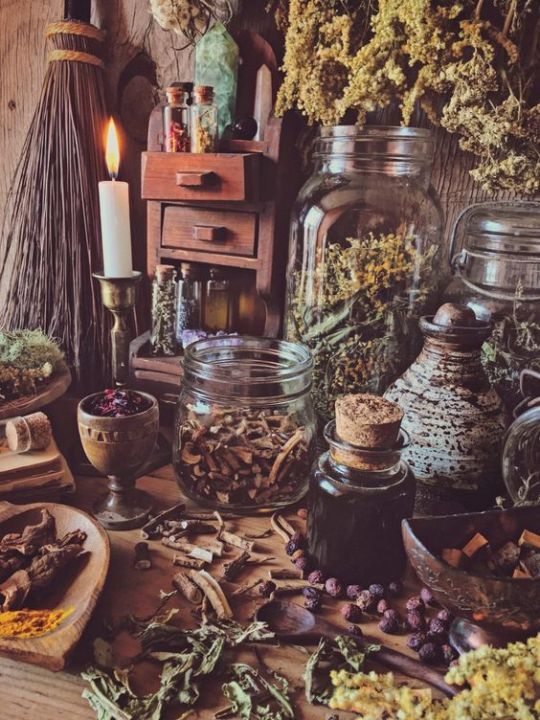
🔮 Witchy Goth & Pagan Shop 🔮
#green witch#witch#witchcraft#occult#pagan#alternative medicine#kitchen witch#witchy tips#witchythings#witchy
1K notes
·
View notes
Text

Spiderweb covered aloe
Spiderweb -
"The Everlasting Cycle of Life: A spider's web serves as a deadly trap for other insects, yet it is also a place where spider eggs hatch, symbolizing the infinite process of death and rebirth, the cycle of life, and the balance between creation and destruction."
Aloe Vera -
"Aloe Vera symbolizes spirituality, good luck, and protection as well as cleansing. It is believed to protect a person from physical accidents and is used to heal minor injuries if they do happen. Drinking Aloe Vera juice is believed to block the influences of evil spirits from harming your body and physical health."
#witchcraft community#witch tips#green witch#kitchen witch#occult#grimoire#divination#plant magic#plant medicine#spiritual knowledge#spiritual meaning#aloe vera#spider web#witch aesthetic#witchy vibes#sigil magic#spirituality#herbal magick#herbal medicine
56 notes
·
View notes
Text
Hmm:

Regarding tenzu tablets:
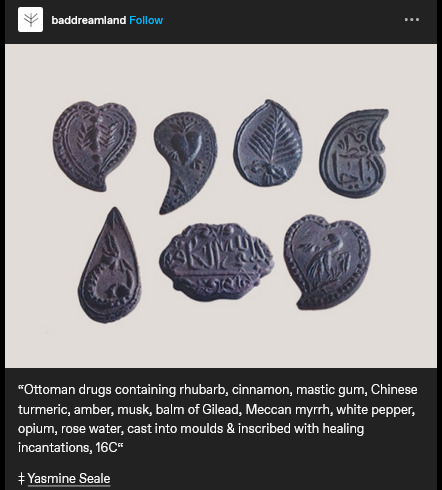
Caption reads: "Ottoman drugs containing rhubarb, cinnamon, mastic gum, Chinese tumeric, amber, musk, balm of Gilead, Meccan myrrh, white pepper, opium, rose water, cast into moulds & inscribed with healing incantations, 16C". Credited with a link to Yasmine Seale, on social media.
Original linked source doesn't mention where these particular tablets/molds were created, kept, displayed, etc. But I wanted to learn more and found a kinda recent summary of tenzu which was published by Nil Sarı (head of History of Medicine and Ethics Department at Istanbul University's Cerrahpasha medical school, president of Health History and Museology Association), which was presented at a conference in 2016:
Nil Sarı. "The Special Pharmaceutical Tablet “Tenzu” in Ottoman Medicine.” 7th International Congress for History of Islamic Medicine, October 24-28, Fez, Morocco, 2016: 24-28.
An excerpt of the text:
In Ottoman Turkish tenzu (tensuh) means "very rare beautiful thing" or "a box containing a variety of fragrances." Tenzu was also said to be the name of a place in Hitay (Eastern Turkistan / Xinjiang) where a medicinal clay - the main ingredient of the tablet tenzu - was imported from. Tenzu was a kind of theriac said to be effective against various ailments. Different tenzu prescriptions are noted in the texts [...] of several medical manuscripts of the 17th and 18th centuries. These tenzu prescriptions were described by various physicians, e.g. the head physicians Salih bin Nasrullah and Nuh Efendi as well as Hayatizade Mustafa Feyzi and Shaban Shifai who were palace physicians of the period. The special pharmaceutical tablet/pastille named "tenzu kursu" was formed in various shapes, i.e. oval, round, or rectangular. A measured amount of the drug preparation was compressed and shaped in a special brass mold named "tenzu kalibi" in Turkish. [...]
Prayers and ornamentations are engraved on the metal molds [...]. The expressions Deva al kulub (Drug for the heart) and Shifa al marghoob (The desired, yearned healing) inscribed on molds reinforce spirituality. [...] Inscriptions around the center of the other flower shaped pattern are Ferd, Hayy, Kayyum and feehi shifaun lin-naas (wherein is healing for mankind, Surah an-Nahl, verse 69). [...] Al-Hayy and Al-Qayyum are often used together. Al-Hayy signifies "ever-lasting life", and Al-Qayyum "self-existing life". [...] Sihhat bad (Have a good health) and Afiyet bad (Have a good appetite) are inscribed. [...] A. Suheyl Unver and Hayri Sozen published several tenzu prescriptions in their book "Turk Farmakaloji Tarihi I.", in 1960. [...] Tenzu prescriptions are found in several medical manuscripts kept in the Topkapi Palace Library, Suleymaniye Library and Istanbul University Rare Books Library.
Clay is a main ingredient [...]. Tiyn-i Tenzu is an unknown red colored clay. However, Terra Sigillata (Tiyn-i mahtum / muhurlu toprak) and Armenian Clay (Kil ermeni) are found in the prescriptions. [...] There are also animal products in the compositions, i.e. ambergris (amber), bezoar (badzehr), kermes (kirmiz), musk (misk), raw silk (harir-i ham / ham ipek), [...] and burnt deer antler (yanmisgeyik boynuzu). There are a wide variety of herbal drugs in the compositions, i.e. Acorus calamus [...], Aloe vera (Sabir), [...] Anchusa offinalis (Lisan-i sevr cicegi), Artemisia absinthium [...], Bambusa arundinaceae [...], Chenopodium album [...], Cinnamon (Darcin), Citrus aurantium [...], Crocus sativus (Za'feran), Embellia ribes [...], Gummi mastix [...], Heliotropium arborsecens [...], Nardustachys jatamansi [...], Potentilla reptans [...], Pterocarpus santalinus [...], Red rose/Rosa gallica [...], Rheum officinale (Ravend), Rumez acetosellaseed [...], Ruta graveolens (Keci Sadefi/Sedef Otu), Terminalia citrina [...], Terminalia chebula [...], Tormentilla (Tormentila).
Shaping and storage of these drugs are explained alongside some of the tenzu prescriptions. According to a recipe, all ingredients are beaten very thin on a porphyry (onyx marble) [...]. Each dose wrapped in gold foil is anointed an amount of almond oil. It is pressed into the mold, dried in the shade and stored in wood boxes. [...] Drugs in tablet form was an old tradition. In general, the preparation is poured onto a tray. [...] After dried in the shade, orange leaves are put between them. Stored in colored glass containers, they're reused when needed, squashed with water and drunk as a syrup. Also, flat pills made of a drachma weight were retained on the tongue in the mouth [...]. Although drugs in tablet form were used throughout Ottoman history either as a pastille or to be converted into syrup, the tenzu tablet molds were designed for the Ottoman sultans and members of the dynasty to make special tablets decorated with calligraphy [...].
[End of excerpt.]
All of these images are cropped screenshots of the PDF scan of the printed "conference works"; the PDF was uploaded online by Nil Sarı.






#sorry some of the non english is messed up because i had to transcribe the text myself from the image scans#also like that the Special Sweets Kitchen of the palace produced medicine
133 notes
·
View notes
Text
Y’all kitchen witchery is a lot of hard work🥲 i give kudos to those who do it
#witchblr#witchcraft#witch#baby witch#witch community#magick#kitchen witch#food#foodie#kichen#kitchen witchery#love for food#herbs#herbalism#magic#herbal remedies#medicinal herbs
95 notes
·
View notes
Text
Herbalism in Times of Turmoil
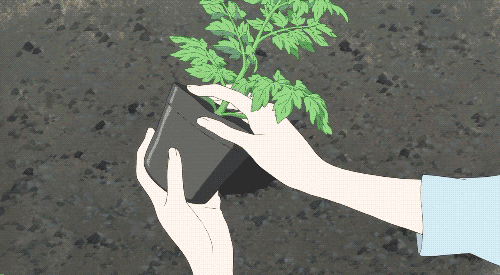
I've recently returned to my roots (pun intended) in folk herbalism to supplement the work I'm doing with my therapist. It wasn't an intentional thing -- in our current round of EMDR, we've uncovered some deeply buried trauma, and bringing that trauma to the surface has shaken the foundations of how I see myself and the world around me. I feel very raw and vulnerable. I feel disoriented and fragile.
I find myself drawn to plant medicine as I navigate this trauma with the help of my therapist. I think a part of me longs for the sympathetic magic of plants -- by taking them into my body, maybe I, too, can become firmly rooted, supported by the earth and nourished by the sun. Maybe I can relearn the magics of stillness and connection. Maybe I can reintegrate into the earth's cycles of death and rebirth.
Some of the plants I'm partnering with in this work are old friends. Others are new allies, recommended by professional herbalists for the type of trauma I'm processing. All of them are supportive in different ways, and all of them have important lessons.
Obviously, I am working with herbs as a compliment to the work I'm doing with a professional mental health counselor, not as a replacement for medical/psychological care. I recommend you do the same, especially if dealing with complex trauma. Even if money is tight, you may be able to get free or low-cost counseling through local social services, nonprofits, university hospitals, etc.
How I Work with Herbs
As an animist, I see working with herbs both as physical medicine and as a working relationship with the spirit of the plant. I don't like to say that I "use" herbs, because that implies that they are just tools. When I say I "work with" an herb, what I mean is that I am partnering with that plant as a living, thinking being that has kindly chosen to support my healing process. I try to honor that relationship in every part of my herbalist craft.
One way I do this is by verbally thanking the plants that I consume as medicine. If I'm drinking a cup of linden tea, I'll say something like, "Thank you, linden, for aiding in my healing today."
I try to use herbal preparations that allow for a sensory experience to help me connect with the plant spirit(s). I don't like taking capsules full of powdered herbs, because that doesn't allow me to see, touch, smell, or taste the plant. I like teas because they allow for a much more intimate connection with the plant's spirit, and I use tinctures when I feel like I need more concentrated medicinal compounds.
I'm a witch who loves plants, but when I'm working with herbs internally, I do not choose them based on their magical or spiritual correspondences. When choosing herbs, I look for quality scientific studies that prove their medicinal benefits, but honestly a lot of plant medicine hasn't been sufficiently studied yet. Because of this, I also look at the way plants are viewed in traditional healing modalities like Western herbalism, Ayurveda, Traditional Chinese Medicine, etc.
While I don't pick them based on their magical properties, I do think studying how these plants are used in magical practices can add an extra layer to my work with them. This helps me to have a more nuanced, deep, and complex relationship with the plant's spirit.
And of course, I always research contraindications and drug interactions before using an herb. For example, I don't recommend Saint John's Wort to anyone taking any kind of pharmaceutical medication because it really messes with the way your body processes your meds. It's also important to research how herbs might interact with other herbs and supplements you're already taking -- that's also a type of drug interaction!
I also try to remember that when we're moving through grief or processing trauma, this changes the way herbs (and drugs, for that matter) affect our bodies. I highly recommend the book The Trauma-Informed Herbalist by Elizabeth Guthrie to learn more about this.
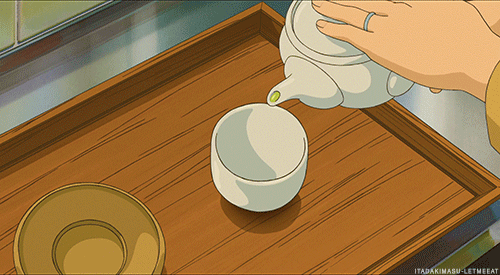
My Herbal Allies
These are the herbs I'm taking focusing my practice on right now:
Ashwagandha and Tulsi are two plant friends that I love pairing together. They're both adaptogens, meaning they can help manage the body's stress response, and come to Western herbalism by way of Ayurveda. I've been working with both of these plants for years, and although they do have different uses, I think they work really well together.
Ashwagandha is really helpful as a pick-me-up for the endocrine system (the system that produces hormones) and nervous system. I find that it has a very grounding effect and is especially helpful for when I feel overwhelmed or burned out. It's a great ally for building resilience when you feel like there's just way too much going on and have no idea how you're going to handle it all. It has a very bitter taste, so I usually add it to coffee or another very bitter beverage.
Tulsi, also called Holy Basil, is a lot more gentle and laid-back than ashwagandha, at least in my experience. It's one of my go-to herbs when I need emotional support. According to herbalists Katja Swift and Ryn Midura, "Tulsi has traditionally been the herb of choice for 'stuck emotions,' whether that's depression or PTSD or just a case of the grumpies." It has a delicious taste somewhere between basil and mint, and I love preparing it as a hot tea. This is one of my favorite herbs right now.
In Ayurveda, ashwagandha is classified as a Rasayana, which means it rejuvenates the body and can promote long life. It is also a Bhalya, meaning it promotes strength, and a Vajikara, which means it promotes healthy sexuality. Tulsi is one of the most valued herbs in Ayurveda and is even called the most sacred plant on earth in the Vedic Puranas. It increases sattva (light, clarity), uplifts the spirit, promotes joy and harmony, and increases prana (vital energy; similar to the concept of chi in China). They're sometimes used together because they're believed to support each other and enhance each other's effects.
I add ashwagandha and tulsi tinctures to my morning coffee and to other hot beverages throughout the day. I also really like tulsi as a tea, and tulsi tea is one of my go-to tools for replenishing my energy after a long day of tarot readings. That being said, I'm considering changing the way I consume these herbs to be more in line with traditional Ayurvedic practices, but I need to do more research first.
Cannabis is, honestly, one of my personal miracle workers, which is a little bit ironic because I also think it's waaaaay overhyped in the wellness industry right now. Cannabis is not a cure-all, and it is not recommended for everyone. There are several different types of cannabis, and each type has its own medicinal uses. For example, the cannabis I use in my personal practice is hemp, which is legally defined as cannabis with little to no THC, meaning it does not produce a high. Marijuana, the type of cannabis with THC, is powerful medicine for some people, but because of how my body and brain work, I personally don't use it. While marijuana use may be illegal depending on where you live, hemp is legal in most places.
I started working with cannabis several years ago to help manage anxiety and insomnia, but nowadays I mostly work with it to help with inflammation and chronic pain.
I find that my body really holds on to trauma in the form of tension, inflammation, and chronic pain. When my trauma response is triggered, I usually feel it as tension or pain, especially in my hips, pelvis, and lower back. I find cannabis really helpful for that stored trauma. It doesn't make the pain go away, but it helps me feel into it and navigate through it. I also find cannabis is really good at relaxing my body and helping me let go of that stored up trauma, almost like unclenching a fist.
Cannabis was historically used throughout the ancient world for divination and religious ritual. It's associated with connection to the spirit world, and may have been used in magical practices like the Norse practice of seidr. Scott Cunningham says hemp is associated with love spells and with Midsummer.
My favorite way to work with cannabis is with a cannibidiol (CBD) isolates. Since I live in a place where THC is illegal and have some health conditions that don't play well with THC, I like CBD isolates because I'm able to make sure I'm getting a THC-free product. I add CBD to my coffee along with tulsi and ashwagandha, and I feel like it helps me process the caffeine better. I also notice rapid relief for joint and nerve pain, anxiety, and intrusive thoughts after drinking this brew.
Meadowsweet is a new plant friend for me. I actually first came across meadowsweet when I was researching handfasting herbs -- it's a traditional inclusion in British handfasting and wedding ceremonies, and was historically used as a "strewing herb," which means it was sprinkled on the ground. It's also a traditional flavor in mead, and in fact the name "meadowsweet" comes from its traditional use in mead-making. (I actually have a batch of meadowsweet mead fermenting right now!)
In herbalism, meadowsweet is prized because it contains salicylates, which can be used to make salicylic acid, the main ingredient in aspirin. This makes it great for pain, especially pain caused by inflammation. It's also great for your digestive system, which makes it a powerful ally if, like me, you suffer from the dreaded "anxiety tummy."
Meadowsweet is a very summer-y plant for me, and its energy reminds me of summer sunshine. It's a plant that reminds me to find joy in the little things in life, and has a very hopeful vibe. This is a plant I associate with both Midsummer and Lughnasa. It's a great friend for when you just need a little sweetness in your life.
On a more physical level, I combine meadowsweet with cannabis, ashwagandha, and tulsi to manage chronic pain rooted in trauma. And, of course, for keeping the anxiety tummy at bay.
In European magic traditions, meadowsweet is associated with love, peace, and joy. Interestingly, Scott Cunningham also talks about the use of meadowsweet for protection from thieves.
I add meadowsweet tincture to my morning coffee along with ashwagandha, tulsi, and CBD. I also really enjoy it as a hot tea, and I think the flavor blends really well with tulsi.
Linden is another new friend for me, but I am obsessed. I don't think I've ever worked with an herb that feels this gentle, supportive, and nourishing to the soul. Katja Swift and Ryn Midura of the Holistic Herbalism Podcast call linden "a hug in a mug," and I think that's a perfect description of how it feels.
In Western herbalism, linden is most often used for heart conditions and to restore the cardiovascular system. However, it also works as a nervine, which means it has a calming effect on the nervous system. It can provide gentle relief for anxiety, tension, and even everyday stress. In Herbal Medicine for Beginners, Swift and Midura even recommend linden to "mitigate the side effects of drying, stimulating medications like Adderall and Ritalin." It is also recommended for nerve pain and damaged nerves.
Linden is wonderful medicine for the heart, both the physical heart and the emotional heart. I really do feel an improvement in my mood when I work with linden. It's soothing and uplifting at the same time.
Magically, linden is strongly associated with protection. It's also associated with love, good luck, and preventing insomnia. Scott Cunningham mentions carrying linden to prevent intoxication.
My favorite way to work with linden is by drinking it as a tea. It tastes similar to chamomile, but a little less fruity. I drink several cups throughout the day, especially when I feel like I need to unwind or calm down.
Rose is one of my favorite flowers. Maybe that makes me basic, but I really do love this plant. The scent of rose has been one of my favorite scents since I was very small -- I remember going to Catholic mass with my mom and praying with my own rose-scented rosary!
We usually think of rose as a decorative flower or an ingredient in perfume, but it also has culinary and medicinal uses. It's used topically to treat skin issues by promoting the growth of new skin cells and to treat rashes and eczema. It can also help soothe gut problems. Rose is also relaxing and anti-inflammatory.
In magic rose is associated with love and romance (duh), divination, healing, fast luck, protection, and connection to the divine. Cunningham recommends it for calming "personal stress and household upheavals" and says the flowers attract fairies. This might be because I was raised Catholic, but rose feels like a very sacred plant to me. In Catholicism it's associated with the Virgin Mary and with some other saints like St. Therese of Lisieux, but I personally use rose more in ancestor work (especially when working with queer ancestors) and for attracting friendly spirits in general.
Right now, my favorite way to work with rose is in aromatherapy. The smell of fresh roses is so uplifting, and it makes me feel like I'm surrounded by gentle, loving protection. I'm sure there are probably health benefits to working with the pure essential oil, but real rose essential oil is VERY expensive, so I use a mild rose-scented perfume instead. (I'm very sensitive to scents and often get headaches from artificial fragrances, but right now I'm wearing Pacifica Beauty's Persian Rose perfume and I haven't had any issues with it.)
Sources:
Herbal Medicine for Beginners by Katja Swift and Ryn Midura
Queering Herbalism, 3rd edition, compiled by Toi of the Herbal Freedom School
The Trauma-Informed Herbalist by Elizabeth Guthrie
Cunningham's Encyclopedia of Magical Herbs by Scott Cunningham
All episodes from the first season of The Trauma Informed Herbalist podcast, but especially the two-part series, "How Trauma Changes Us"
"Herbs for Psychological First Aid" from The Holistic Herbalism Podcast
"Herbs & the Holidays: Emotional Support" from The Holistic Herbalism Podcast
"Working With Herbs For Chronic Pain" from the Holistic Herbalism Podcast
"The Centuries-Old Secrets of Gender-Affirming Herbalism" by Leah Kirts
"How To Incorporate Hemp In Your Materia Medica" by Heather Saba
"Cannabis: Potent and Versatile Medicine" by Sue Sierralupe & Candace Hunter
"An Ayurvedic perspective on Marijuana" by Shilpika Devaiah
"Who shouldn't use medicinal cannabis?" by Corinne Hodgson
#herbalism#plant medicine#plant magic#green witchcraft#green witch#trauma#trauma healing#complex trauma#ashwagandha#tulsi#ayurveda#cannabis#cannawitch#meadowsweet#linden#rose#tea magic#tea witch#kitchen witchcraft#kitchen witch#queer herbalism#witchblr#witch#herbs#animism#animist herbalism#long post#my writing#mine
433 notes
·
View notes
Text
Rosemary; Salvia rosmarinus


rosemary is a very powerful little plant and I recommend it as a witch's essential herb, a non-negotiable if you will, as it has so many uses.
Other names: sea dew, compass plant, polar plant
Nutritional and Medicinal Fun Facts:
Good for hair and scalp
Good for metabolic health
High in carnosic acid which has anti-cancer properties
Improves memory and concentration
Improves eye health
Can help regulate liver
Aeromatic may help reduce asthma symptoms
Aeromatic and eating it can help reduce stress and anxiety
May reduce inflammation
May help increase circulation
High in antioxidants, manganese pantothenic acid, niacin, thiamin, folate, and riboflavin
extra fun fact: part of the mint family; eucalyptol (camphor-like) and alpha-pinene (pine-like) are the compounds that primarily give the rosemary flavor
~Magical Properties & Lore~
Element: Fire
Planet: Sun
Gods: Apollo, Helios
Goddess: Aphrodite, Hebe
Spells & Rituals:
Love spells
Beauty spells, especially in an aromatic
Health spells and rituals; I also use it in spells to break unhealthy habits
Antifertility spells (along with safe sex! mundane first, always)
Protection and banishing spells regarding negative spirits; especially visitations at night
Sachets, tea, or aromatic for spells to improve intelligence and memory; excellent herb for student
Helps with nightmares and remembering dreams
Use as a tea or aromatic for dream work and past life remembrance
Burn to cleanse home or self of negative energy
Grow it inside to purify the air
Tip: pairs powerfully with Juniper in most situations
Lore:
Christians believe it grows for 33 years until it is the same height as Jesus. They believe it got blue flowers when Mary placed her cloak on it when fleeing to Egypt. It is a Christian symbol of fidelity and remembrance.
Couples should plant on their wedding day and interpret the growth as divination for the family.
Couples have also wore it at their wedding and given as favors to their guests.
Said to protect against the evil eye.
In Wales, it was used as a funeral favor and sprigs were lowered with the casket.
Embalming herb in ancient Egypt
Ancient Greece & Hellenism
Symbol of love, beauty, and eternity
Said to help people retain youth when smelled
Increases memory; students would wear garlands of rosemary for exams
Protection against evil
recipes to eat it in: so good on chicken, fish, and potatoes, rosemary-infused olive oil, rosemary and lemon pasta
#kitchen witch#kitchen witchery#hearth witch#hellenism#hellenic#helpol#pagan#spells#rituals#cleansing#lore#medicinal herbs#protection spells#evil eye protection#spirit work#divination#dream work#rosemary#aphrodite#apollo#hebe#helios
90 notes
·
View notes
Text
Everything You Need to Know About Herbs : Ginger (root)
Ginger (Zingiber officinale)
*Kitchen Herb *Medical Herb *Masculine
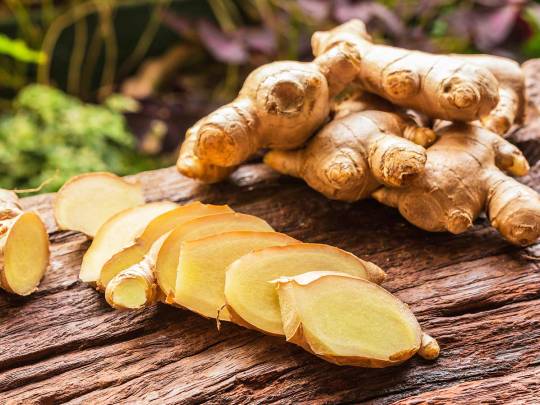
Folks Names: African Ginger, Sheng Jian, Singabera
Planet: Mars
Element: Fire
Deities: Hecate, Ameretat, Artemis
Abilities: Love, Money. Success, Power, Safety
Characteristics: A perennial plant growing to 2 ft with lance-shaped leaves and spikes of white or yellow flowers. Is native to Asia and is grown throughout the tropics. Ginger prefers fertile soil and plenty of rain.
History: Wild or cultivated, ginger root is an ideal herb to add to rituals and spells because it acts like a booster for the power involved. Apart from its use as a spice and as a base for alcoholic liquors of one kind or another, ginger has for a very long time enjoyed a reputation for medicinal use, from the prescription of Arabian and Persian doctors for impotence, to its still popular reputation as a stomach settler, and this use dates from the earliest records. Ginger tea, even ginger biscuits, help to combat travel sickness, or morning sickness and nausea generally. It was used for asthma in Russian folk medicine. The recipe given is a pound of ginger grated, put in a quart bottle, which was filled with alcohol. This was kept warm for two weeks, shaken occasionally, until the infusion was the color of weak tea. This was strained, and the sediment allowed to settle. Then the liquid was poured into another bottle, and the infusion taken twice a day.
How to Grow:
Easy to Grow: Yes
Rating: Beginner Friendly
Seeds Accessible: Sort of but root is
How to Grow Ginger (article)
How to Grow from Seeds
How to Grow from Store Bought
Where to Buy Seeds
Magical Properties:
Can boost the power of spells and rituals with its own heat like energy when consumed beforehand
Used to jump-start love, stimulate finances, and increase potential success in anything
In an elixir, the root acts as an energizing tonic and brings strength, courage, and health
Putting ginger in your pillow can create a better night’s sleep
Can give protection during childbirth
Whole ginger roots planted and grown can attract money, along with sprinkling powdered ginger into one’s pocket
Dobu islanders with chew and spit ginger at the “seat” of an illness to cure it and to halt oncoming storms
To promote lust, sprinkle ginger around your home
Medical Usage:
Speeds up the rate of gastric emptying and aids the absorption of nutrients from the digestive tract, which helps treat anemia
Relieves nausea and vomiting, especially with morning sickness
Reduces muscle pain after exercise and is effective against menstrual pain
Excellent remedy for indigestion, nausea, gas, bloating, cramps and other digestive complaints
Stimulates circulation and helps with the flow of blood to the surface
Remedy for coughs, colds, flu and other respiratory problems
Stimulates sweating and helps to cool and control fevers
Sources
#witchblr#witch community#witchcraft#paganblr#occulltism#nature#green witch#plants and herbs#herbalist#witchcraft 101#witch resources#kitchen witch#nature witch#botany#ginger#medicinal herbs#plantblr#pagan witch#hecate
83 notes
·
View notes
Text
HERBS for Digestive Health🌿
To help improve and ease digestive disorders and issues.
Ginger
widely used to treat nausea, bloating and soothe digestive issues
Turmeric
used for digestive weakness and inflammation
Chamomile
helps settle inflammation and anxiety related stomach issues
Fennel
great to reduce bloating, cramping and relax stomach muscles
helps break down food
Cinnamon
helps regulate circulation, blood sugar levels, and digestive function
Rosemary
supports healthy digestive functioning
Increasing your consumption of some of these even slightly could make a big difference over time! Should be used with caution.


#digestion#digestivehealth#gut health#herbs#medicinal herbs#herbal treatments#herbal tea#herbal#natural healing#health#healthy#healing#spirituality#witch community#witchblr#spiritual#herbs and spices#plants and herbs#tips#kitchen tips#natural medicine#stomach issues#stomach problems#digestive disorders#chamomile#ginger#fennel#rosemary#inflammation#digestive system
333 notes
·
View notes
Text


(wip) Bloody Medical Malpractice Yuri Concept
[under cut for blood]


I dont even know the lore to this I just felt like drawing it lol… The things she’d do for a Kumar 2.0 i guess???
May finish this to test things lets find out!
There’s also this where she tries to clean them up proper:

#Kaalaa Baunaa#Medicine Pocket#KaalaaPocket#MediBaunaa#cw blood#mochadoodles#instead of using my art skills for good i use it to make vile reverse 1999 rarepair fanart#enjoy#the kb one is cleaner bc i like her better tysm#im cooking except the kitchen is on fire#up next: bloody verneider because im evil#i literally speedran the medpoc one 😭#medpoc girlkissing collection#implied that medpoc is High off their meds#reverse 1999#i can fix them (yearning for a person no longer there)#i want to give kaalaa baunaa the happiness she RIGHTFULLY deserves but the horrors intrigued me and took me away like an abraxas @ regu#the homoeroticism of staining your loved / adored one with contaminated blood knowing you're probably doing the same to her psyche#oh she def cant fix them but CAN THEY FIX HER??? CAN THEY???#most would say no but hear me out#*proceeds to not elaborate*#nblw turbulence in girlkiss realm#will happen again#sorry chat its almost 12 midnight the rot is taking over#im sorry to anyone who had to witness this 😻
31 notes
·
View notes
Text

#witchcraft#witchyvibes#witch community#green witch#kitchen witch#herbal remedies#witchy tips#herbal medicine#witchy recipes#tea
423 notes
·
View notes
Photo








From sketches to final works.
#stalker#andrei tarkovsky#Anatoli Solonitsyn#liquidators#chernobyl#medicine#traditional art#S.T.A.L.K.E.R.#strelok#penitent one#blasphemous#game kitchen
221 notes
·
View notes
Text
What are Infused Oils?
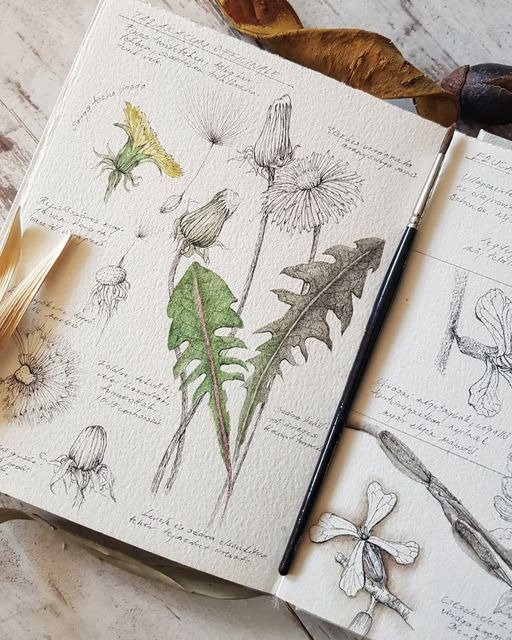
What are they?
Infused oils are herbal components or spices placed in a jar of carrier oil like Olive Oil, Grapeseed Oil, Avacado Oil, Jojoba Oil, Coconut Oil, etc. Can be used in cooking, herbal ailments and skincare.
Are they essential oils?
No. Short answer, no. Long answer? I'll give you an explanation. Essential oils are distilled using Steam Distillation, Solvent Extraction, CO2 Extraction, Maceration, Enfleurage, Cold Press Extraction, and or Water Distillation. Lotta words huh? It takes a lot of work to make essential oils. Unfortunately, it also takes quite a bit of that plant to make even those tiny 10ml bottles you purchase. Of course, each plant varies. However, it still can lead to a larger environmental impact.
For instance, one pound of essential oil can be extracted from approximately 250 pounds of rosemary leaves, or from 150 pounds of lavender buds, or say 50 pounds of eucalyptus leaves. This is why you see some as more expensive than others. Unfortunately, you can see where the problem lies in plants that are more threatened or endangered. If you must use essential oils, source responsibly (and not from a Pyramid scheme but I'm not opening that can of worms)
Can I use infused oils in my practice?
Yes! Absolutely! All these oil recipes you see for spell oils are exactly that. You can even use the elemental correspondences of the carrier oils you use for spell oils. As an example Olive Oil is traditionally known for the fire element and Coconut Oil is water. The possibilities for your personal correspondence are endless!
Now I'll stop rambling. Here are a few methods I learned to infuse oils in my courses and through self-herbalist study.
Method One:
The Folk Method - The most common
Directions
Place DRIED herbs in a clean, dry jar. Leave at least 1 to 3 inches of open space above your herbs to cover with oil.
Fill the remaining space in the jar with the oil of your choice, making sure to cover herbs by at least 1 inch or more. If the herbs emerge above the surface of the oil at any point while infusing, pour more oil on top to ensure the herbs remain covered.
Cap the jar tightly and shake well.
Place the jar in a sunny, warm windowsill and shake once or more per day.
After 2 to 3 weeks, strain the herbs out of the oil using cheesecloth or a mesh strainer. Or you can leave it in but straining is recommended if you are using dropper bottles as it clogs the caps.
Pour into clean glass bottles.
Remember to label your jars with the date, type of oil, and herbs used! You WILL forget! Trust me.
Store in a cool, dark place. The oil may keep for up to a year.
Method Two:
The Heat Infused Method - Quick Infusion
Directions
Place herbs in the crock pot or double boiler. Cover with extra virgin olive oil (or other carrier oil of choice), leaving at least an inch or two of oil above the herbs.
Gently heat the herbs over very low heat (preferably between 100° and 140° F for 1 to 5 hours, until the oil takes on the colour and scent of the herb. Some recommend heating the oil for 48 to 72 hours at a controlled temperature of 100° F. Turn off the heat and allow it to cool. I personally prefer letting it sit in a crock pot for 72 hours as I feel like I get all of the benefits out of the herb.
Once oil is cooled, strain using cheesecloth.
Bottle in dry, sterilized glass bottles. LABEL your bottles with the date and contents before storing them.
Store in a cool, dark, dry place for up to six months.
Best herbs to infuse in oil
There are a countless number of herbs, spices and resins that can be infused into the oil. Please make sure these herbs are free from pesticides and chemicals (not found on the roadside). Dried herbs work best as you don't want your mixture spoiling sooner. Here are some great examples of herbs to use.
Pine needles
Calendula flowers
Chamomile flowers
Lavender
Lemon balm
Peppermint leaf
Rosemary leaf
Thyme leaf
There you have it! Now have fun and source responsibility.
Happy witching!
Want to read more?
On sustainability and impact:
Links:
Dangers of essential oils and pets:
Link:
Want to check out my other post? Look at my Masterpost
#witchcraft#witch#infused oils#spell oils#essential oils#aromatherapy#kitchen witchcraft#herbal magic#herbalism#herbalist#herbal medicine#witchblr
23 notes
·
View notes